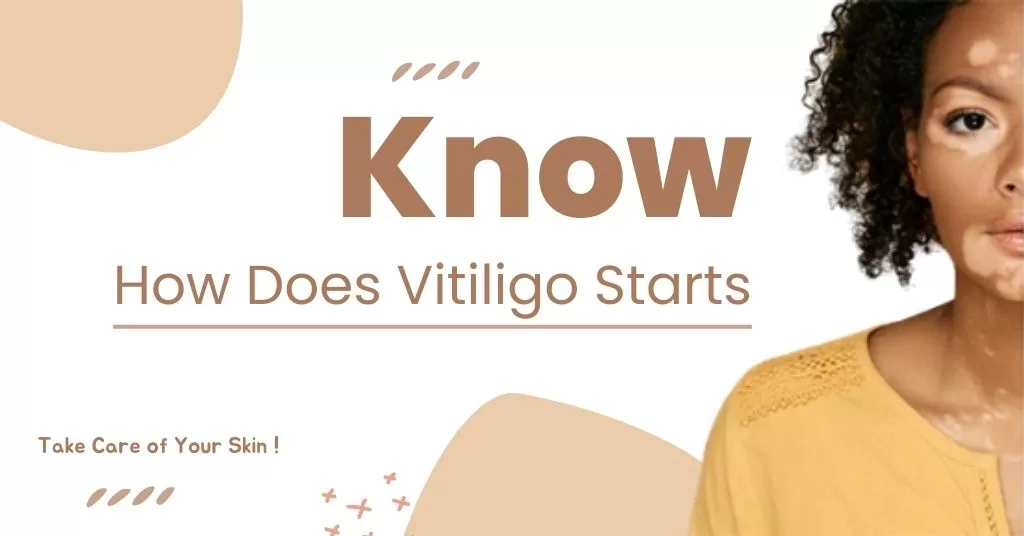What is Vitiligo?
Vitiligo is a long-term skin condition in which the skin pigment is lost, causing white spots on the skin. Melanin is the pigment that gives colour to skin, hair and eyes. The white patches are caused when the cells responsible for producing melanin, called melanocytes, are destroyed or inactive.
It is genetic, so if a grandfather or father in your family had the disease, you may also experience some of its symptoms. Autoimmune and environmental factors are a few of the significant causes. An autoimmune response plays a vital role in the development of this condition, where the body’s immune system mistakenly attacks its own melanocytes and destroys them. These white spots can appear anywhere in your body.
Vital causes and symptoms of vitiligo
- In the early stages of the disease, yellow or white patches develop on the skin. Such spots can occur on any part of the body and are small in the beginning.
- Skin colour loss in patches that typically starts on the hands, face, and in nearby areas of the groin and bodily openings
- Loss of colour in the mucous membranes, the tissues lining the inside of the nose and mouth. If it is not treated at the right time, it can become bigger with time.
- Premature greying of hair: People with the disease, may experience premature greying of hair in areas of damaged skin, including the scalp, eyebrows, and eyelashes.
Vitiligo is a long-term condition, and its progression can vary from person to person. Although it is not contagious or life-threatening, the effects can significantly impact a person’s appearance and quality of life.
How vitiligo progresses over time
Vitiligo develops differently in each person, and it is challenging to predict how it will develop over time. While random or sudden changes may be seen in some people, steady and gradual progression of the disorder may be seen in others.
The following are some factors that affect how it progresses:
Individual Variations: The treatment procedure varies from patient to patient, and what may be suitable for one person may not be suitable for another.
Age: Vitiligo that appears early in life, especially in childhood, may be more irregular and possibly aggressive.
Autoimmune factors: Melanocytes are mistakenly attacked by the immune system, causing the condition, which is classified as an autoimmune disease. Controlling autoimmune variables and their progression may help slow the progression of the disease.
Environmental causes: It can be brought on or worsened in certain people by stress, trauma, and exposure to specific chemicals or environmental causes.
Physical and Emotional Challenges
People suffering from vitiligo face various challenges, both physical and emotional. Some common issues include:
- Psychosocial effects: Vitiligo can have a psychological and emotional impact on individuals. Some people feel embarrassed or worry about how others perceive them. This can affect self-esteem and confidence.
- Social stigma: Misunderstandings and misconceptions about vitiligo can contribute to social stigma. Lack of awareness of the condition can lead to adverse reactions from others, potentially affecting relationships, friendships, and professional interactions.
- Sun sensitivity: White skin is more sensitive to sunburn because melanin, which provides natural sunlight protection, is reduced or absent. Individuals suffering from the disease must take extreme precautions to protect their skin from UV radiation.
- Medical management: Treatments, like allopathic treatment for vitiligo and ayurvedic medicine for vitiligo, can have detrimental effects on the patient’s condition, causing their symptoms to become severe.
Tips for managing emotional and physical challenges
- Avoid excessive sunlight, wear protective clothing, and regularly apply sunscreen made from natural ingredients.
- Increase your self-esteem by surrounding yourself with family and friends who will not discriminate against you.
- If you wear make-up, remember that you should remove the make-up before sleeping at night. Otherwise, the chemicals can harm you.
- You can take Homeopathic treatment for vitiligo, which has no side effects.
Can vitiligo be affected in children?
Vitiligo can affect any age, even young children. Treating children’s vitiligo can be particularly difficult because of issues such as self-esteem, social interactions and general well-being. Here are some things to think about and advice for parents or guardians of children with this disease.
Open communication:
Encourage your child to talk to you openly about how they feel about having the disease. Establish a welcoming atmosphere where people can voice any worries or inquiries.
Education and awareness:
Teach your child about the condition in an acceptable way for their age. Give brief explanations of the illness, stressing that it is not communicative and has little bearing on their general health.
Incentive:
Instead of paying too much attention to your child’s looks, focus on their skills, talents and hobbies. Encourage self-worth and accept their individuality.
How effective is homeopathy for vitiligo?
Homeopathy is an effective treatment option for vitiligo. Natural remedies for vitiligo stimulate the body’s natural healing processes to restore balance and harmony. Homeopathic remedies are made from natural materials, making them safe and not harmful. Vitiligo homeopathic treatment focuses on the condition’s underlying causes, including autoimmune and genetic factors. The treatment also helps improve the immune system, which plays a key role in developing the disease. Only by getting proper treatment and completing the treatment can you get relief from the symptoms.
The speciality of Barat Homeopathy Clinic
When patients come to Bharathomeopathy Clinic for treatment of their disease, our doctors take information from them about their previous treatments. And this is the most important thing about our Bharat Homeopathy Clinic. The skin doctors at the clinic start treating vitiligo only after knowing the patient’s medical history. We also keep a regular follow-up with them from time to time. They give patients better diet plans and side-effect-free homeopathic medicine for vitiligo, after which they start getting relief from the disease in no time. By completing this treatment and following the prescribed rules properly, the patients can get back to their daily routine in a healthy way.


